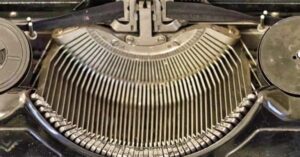Allow me to transport you to a bygone period where the enticing aroma of ink and the rhythmic dance of typewriter keys permeated the air. For a brief moment, close your eyes, and picture yourself enthralled with the typewriter’s magic while perched on your mother’s lap. Oh, the times gone by!
Typewriters’ Melancholic Symbol
In the world of touchscreen adventures and digital marvels of today, the typewriter is a somber reminder of a bygone era. It transports us to a bygone period in which writing down ideas and tales required pressing delicate keys that left a lasting impression of ink on paper. Each key clicked satisfyingly, producing a melody that conveyed volumes. It was like listening to music.
Typewriter Evolution: A History
The origins of mechanical writing instruments may be traced back to the 18th century, which is when typewriters first became beautiful. Functional typewriters did not appear until the 19th century, and they brought a flood of innovation with them. The Sholes and Glidden typewriter, popularly referred to as the Remington No. 1, made its debut in 1873 and is considered a miracle.
This brilliant creation was a significant advancement in the field of mechanical writing. It brought to the “QWERTY” keyboard layout, which is still in use today and fixed the issue of early typewriters’ letter combinations becoming stuck all the time. The typewriter we are familiar with today was thus created.
The Impact of Ripples on Society and Communication
It is impossible to overstate the influence typewriters have had on society and communication. Let’s pause to consider the areas that were impacted by it:
Enhanced Quickness and Effectiveness
Typewriters, which outperformed handwritten transcripts in speed, completely changed the way we create and generate documents. These talented typists went on to become maestros of invention, instilling a new level of productivity in offices and businesses worldwide.
Document Standardization
Each keystroke on a typewriter produced a mark of consistency, leading to documents that were incredibly accurate. This characteristic was especially crucial for the production of official and legal documents.
upporting Print Media and Newspapers
The pulse of the newspaper industry quickened with the repetitive dance of typewriter keys. It made quick news aggregation possible and solidified newspapers’ position as the primary information source. The literary scene changed as more people entered the field of professional writing and correspondence as typewriter prices decreased.
Preserving Our Heritage
Typewritten documents were rarely as persistent as their handwritten counterparts. They were essential in keeping our legacies alive by safeguarding literary gems and historical documents. The typewriter turned become a silent narrator of history, whispering tales of the past to everyone who will listen.
Continued Legacy: Typewriters in Contemporary Tapestries
Typewriters were pushed to the sidelines by the digital revolution, yet their legacy lives on in the contemporary world. Let’s explore some of the ways that typewriters are still ingrained in our daily lives:
Wanted Antiques
Due to their timeless appeal, vintage typewriters have become highly sought-after antiques, drawing collectors and aficionados. These devices are not only beautifully designed, but they also carry stories from the past and the history they stand for. There’s a strong nostalgic feeling to the sound of typewriter keys clattering and the tactile feel of typing. Some authors even claim that the tactile act of typing on a typewriter stimulates their creative juices.
Creativity & Originality
Typewritten text has been subtly incorporated into artwork by designers and artists, fusing the inventiveness of the present with the nostalgic charm of typewriters. Art, literature, and film are given a timeless quality through this delicate dance between eras.
Typewriters have graced books’ pages, movies’ frames, and artwork’s canvases. They still have a place as instruments for creativity and focus in contemplative writing retreats and immersive workshops. Writers are guided on an exploratory trip by the rhythmic cadence of typewriter keys, which ties them to their literary past.
- The typewriter is a symbol of creativity and inventiveness, a poignant remembrance of a bygone era that speaks its story to those who are willing to listen. Even though it is no longer the symbol of technological advancement, its legacy still illuminates the paths of writers, artists, and enthusiasts. Thus, let’s appreciate the connection that the typewriter creates between the past and the present and accept its clattering cadence.


